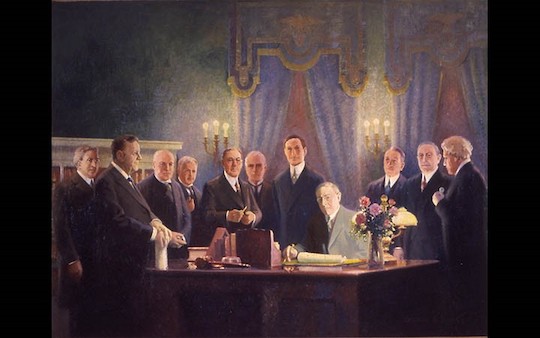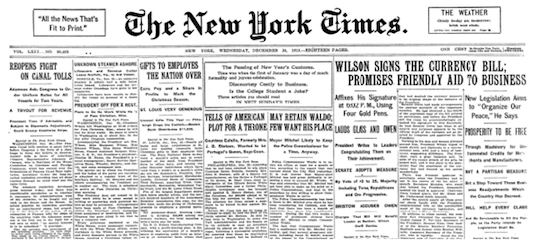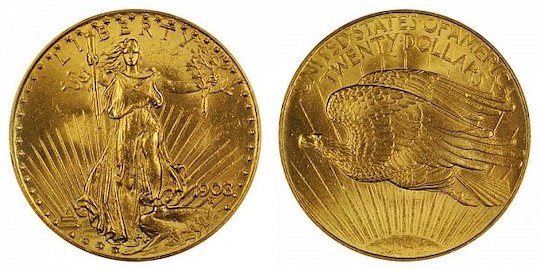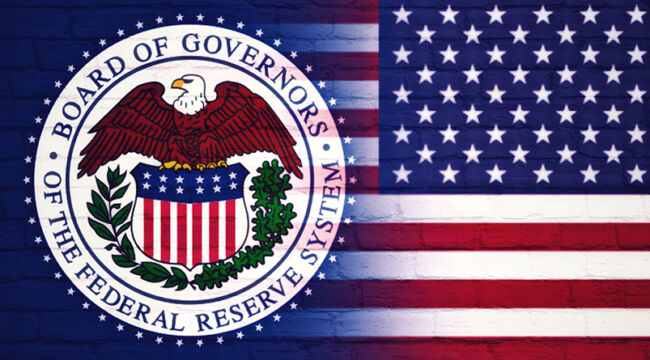Dec. 23, 1913
“I’ll do the deed first,” said the president of the United States, Woodrow Wilson. “And then I’ll have something to say.”

President Wilson signs the Federal Reserve Act. Painting in 1923 by Wilbur G. Kurtz; courtesy of Woodrow Wilson Presidential Library and Federal Reserve Bank of St. Louis.
With a gold pen in hand, Wilson signed his first name, “Woodrow.”
He set that pen down and picked up another gold pen, with which he wrote the first part of his last name, “Wil.” And then with a third gold pen, he repeated the procedure to finish his last name, “son.”
“I’m using a series of pens,” said Wilson in a lighthearted tone, nodding toward the writing implements now arranged side by side on the mahogany desk.
“Yes,” said Sen. J. Hamilton Lewis of Illinois. “Just as the bill came forth in installments,” another spirited comment that elicited laughter from the observers assembled in the Old Executive Office Building, adjacent to the White House.
And indeed, as gatherings of important people go in Washington, D.C., this was quite a crowd.
Onlookers to Wilson affixing his signature included numerous Cabinet officers: the secretaries of the Navy and of War, as well as Interior, Agriculture, Commerce and Labor.
The Postmaster General was there too. And Speaker of the House Champ Clark, along with Rep. Carter Glass, chairman of the House Committee on Banking and Currency, and Sen. Robert Owen, head of the Senate Committee on Banking and Currency.
When the Act of Congress was signed, Sen. William Chilton of West Virginia stepped forward with another imprint of the same document. He handed the papers to Wilson, along with a fourth gold pen, and asked for a copy with the president’s signature, a request to which the nation’s chief magistrate smilingly obliged.
And so it was that on Tuesday evening, Dec. 23, 1913, President Woodrow Wilson signed the Federal Reserve into being. He used four gold pens, symbolic not just of the law at the time, but of the very idea of money, from ancient days to the present.
Just a “Currency Law”

Front page of New York Times, Dec. 24, 1913, announcing “Currency Bill.”
In its next-day edition of Dec. 24, 1913, The New York Times called the law Wilson had signed a “Currency Bill,” intended to bring “Friendly Aid to Business.”
On the same day, in Boston The Christian Science Monitor led its story with a simple declaration, that “The Glass-Owen currency bill is now law.”
This was, per the Science Monitor, the “Dawn of a New Day.” And further, “President Wilson Says It Will Give Merchants System of Free Credits First Time in 50 Years.”
In the middle of the country, The Omaha Daily Bee headlined its edition of Dec. 24 that the bill set up a system of “Free, Elastic, Uncontrolled Currency at Disposal of Business Men.”
The Dollar Was as Good as Gold
Still, with or without this new law, the legal money of the United States was based on solid, mined-from-the-ground gold per the Gold Standard Act of 1900.
This law, signed by President William McKinley, formalized the long-standing use of gold as the basis for U.S. currency, fixing the value of one dollar as equal to 25.8 grains of 90% pure gold.
(And what was this “grain,” you might wonder? It’s part of a system of weight and measure with historical roots in the Bronze Age, when people calculated value based on the weight of, literally, a grain of wheat or barley. In more modern times, a grain is defined as a mass of 64.79891 milligrams.)
By the late 1800s and early 1900s in the U.S., a $20-gold piece was made of 90% gold and 10% copper, the latter metal used to increase hardness of the alloy. In total, it weighed 33.436 grams (note: One troy ounce is 31.1 grams), giving a final tally of .9675 ounces of gold in every such coin of the realm.

U.S. 1908 Saint Gaudens gold $20 “double eagle,” Note: no motto/In God We Trust
The Dollar’s Lost 99% of Its Value Since 1913
And as the U.S. monetary system stood, this is how things were established on Christmas Eve, 1913, when President Wilson used four gold pens to sign a new law to create a central bank for the U.S., and to help U.S. business better function in a world still working on a classical gold standard.
Now, not quite 110 years later and in no small measure due to long-term efforts of the Federal Reserve, that old $20 American gold coin is worth nearly $2,000 just for the precious metal, let alone the scarcity premium and markup for whatever value may come with numismatic rarity.
In other words, do the math here: Over the past century and one decade, the value of a dollar has declined by 99% if you use gold as the basis for comparison.
Looking ahead, where do things go? Well, we could discuss it all day.
Returning to the Scene of the Crime
Why broadcast from Jekyll Island, you might ask? Because Jekyll Island is Ground Zero for the modern American monetary system. It’s where a small group of bankers met in November 1910 to hammer out details of a plan that evolved into the Act of Congress that President Wilson signed on Dec. 23, 1913.
In the context of American history, Jekyll Island was a critical point, truly a fulcrum of events.
In particular, that Jekyll Island meeting was when and where the monied interests of a newly industrialized country looked back at a series of economic crises and panics that marked the story of the nation.
They reviewed serial breakdowns of commerce in 1812, 1818, 1825, 1837, 1847, 1857, 1873, 1884, 1890, 1893, 1903, 1907 and even the year of the meeting, 1910. And they were determined to do something to remedy the economic flaws of the evolving American system.
In essence, according to the Jekyll Islanders, every crisis or panic was rooted in a signal deficiency of U.S. commerce, namely not enough money in circulation at critical moments in time. That is, every so often, not enough silver and gold in the pockets of the people and the accounts of business interests.
An “Elastic” Currency
The remedy, thought the economy-planners, was an “elastic” American currency, one in which the supply of money could expand or retract depending on business conditions. Distill it all down to the basics, and this led to the idea of a “central bank,” one that would manage the supply of currency. At root, this was behind the creation of the Federal Reserve.
Looking back with the benefit of a century’s hindsight, it’s fair to ponder whether or not the Federal Reserve was a successful idea, or perhaps an abysmal monetary, political and even social and cultural failure.
Begin with a charitable view, perhaps, that no institution is entirely good or completely bad. And then the question arises as to whether the Federal Reserve has provided more benefit to America and its people than it may have caused harm.
These are deep ideas, and they’ll be the subject of discussion by Jim Rickards and Danielle DiMartino Booth this coming Wednesday.
Jim and Danielle will look back, look at the present and most importantly look ahead to the future, to the U.S. and global economy that is fast evolving. The context will be through the lens of the Federal Reserve, an idea hatched at Jekyll Island and signed into law a few years later by President Wilson and those four gold pens.
I hope to see you there, on the viewer list and watching live from Jekyll Island, at one of the most important talks of the year.



Comments: